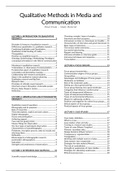Class notes
Qualitative Methods - All Exam Material (according to study guide)
- Course
- Institution
- Book
All the exam material according to the study guide created by the teachers. Everything you need to know to pass the exam in 30 pages! Structured per lecture, then per subject.
[Show more]




